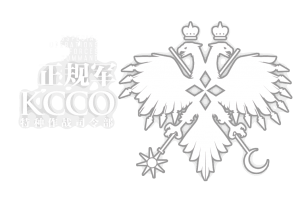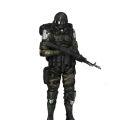KCCO: Difference between revisions
No edit summary |
Add some information, trivia, and history. |
||
| Line 1: | Line 1: | ||
{{Incomplete|reason=story after Chapter 10}} | {{Incomplete|reason=story after Chapter 10}} | ||
[[File:KCCO_Logo.png|300px|frameless|right]] | [[File:KCCO_Logo.png|300px|frameless|right]] | ||
'''[[wikipedia:Special Operations Forces (Russia)|Special Operations Forces]] | The '''[[wikipedia:Special Operations Forces (Russia)|Special Operations Forces Command]]'''<ref>[https://en.wikipedia.org/wiki/General_Staff_of_the_Armed_Forces_of_the_Russian_Federation#General_Staff_organization Wikipedia entry on the KSSO]</ref> (特种作战司令部, Командование сил специальных операций; KCCO, KSSO), or the '''Regular Army''' (正规军) in Chinese, Korean, and Japanese version, was a Russian, later Soviet strategic-level special forces command and a sub-branch of the Neo-Soviet Army, and later turned rebel group. It was the supporting, later turned second antagonistic faction of [[Girls' Frontline]]. The KCCO's true objective was to tear up the peace treaty between the [[Soviet Union|Neo-Soviet Union]] and the [[Pan-European Union]], to reignite [[World War Three]] and make the Neo-Soviet Union the final victor of the war. Its plan was foiled by the [[Soviet Union#Bureau of State Security|Bureau of State Security]] and [[Griffin & Kryuger]]. | ||
Under [[General Carter]]'s command, KCCO was made up of highly trained human veterans, most of which survived World War Three, as well as military-grade robots, drones, vehicles, and mechs. In fact, KCCO deploys its mechanical units more frequently than its human | Under [[General Carter]]'s command, the KCCO was made up of highly trained human veterans, most of which survived World War Three, as well as military-grade robots, drones, vehicles, and mechs. In fact, the KCCO deploys its mechanical units more frequently than its human operators, which is why [[the Commander]] and Griffin's [[Tactical Doll|T-Dolls]] mostly encountered the KCCO's mechanical units. | ||
==Story== | ==Story== | ||
| Line 9: | Line 9: | ||
''Main article: [https://en.wikipedia.org/wiki/Special_Operations_Forces_(Russia)#History Special Operations Forces' History]'' | ''Main article: [https://en.wikipedia.org/wiki/Special_Operations_Forces_(Russia)#History Special Operations Forces' History]'' | ||
In 2009, as a part of the comprehensive reform of the [https://en.wikipedia.org/wiki/Russian_Armed_Forces Russian Federation's Armed Forces], Special Operations Directorate, subordinate directly to the Chief of the General Staff, was created on the basis of the [https://en.wikipedia.org/wiki/GRU GRU]'s in the [https://en.wikipedia.org/wiki/Moscow_Oblast Moscow Oblast] (Military Unit 92154). The unit saw extensive action in the Caucasus region and earned the nickname podsolnukhi (sunflowers), a nickname given to the soldiers assigned to the unit while serving in [https://en.wikipedia.org/wiki/Chechnya Chechnya]. It was reported that Colonel Oleg Martianov, who later became a member of the board of the [https://en.wikipedia.org/wiki/Military-Industrial_Commission_of_Russia Military-Industrial Commission], was one of the founders and first commander of the SOF from 2009 to 2013. Later in 2012, the Special Operations Directorate was reorganized as Special Operations Command (or the KCCO), which was followed by plans to upscale the Forces manpower up to 9 special purpose brigades. After the rise of the [[Soviet Union|Neo-Soviet Union]] in 2032, the KCCO still served it as its special forces command. | |||
===World War Three=== | ===World War Three=== | ||
| Line 16: | Line 16: | ||
===Sangvis Ferri HQ joint assault=== | ===Sangvis Ferri HQ joint assault=== | ||
In 2064, the KCCO organized a joint assault with the PMC [[Griffin & Kryuger]] to destroy the [[Sangvis Ferri]] HQ and put an end to the rebellion of the Sangvis Ferri T-Dolls. The operation was actually a ploy by the KCCO to arrange an encounter between the Sangvis Ferri Mastermind {{enemy name|Elisa|boss}} and the [[AR Team]] T-Doll {{doll name|M4A1|AR|4}}, which William believed would create an entity able to reactivate Relics, breaking the [[Relic Arms Limitation Treaty]] and providing the West a casus belli to restart the war. | In 2064, the KCCO organized a joint assault with the PMC [[Griffin & Kryuger]] to destroy the [[Sangvis Ferri]] HQ and put an end to the rebellion of the Sangvis Ferri T-Dolls. The operation was actually a ploy by the KCCO to arrange an encounter between the Sangvis Ferri Mastermind {{enemy name|Elisa|boss}} and the [[AR Team]] T-Doll {{doll name|M4A1|AR|4}}, which William believed would create an entity able to reactivate Relics, breaking the [[Relic Arms Limitation Treaty]] and providing the West a casus belli to restart the war. | ||
''To be add'' | |||
==Mission and methods== | |||
The KCCO was a highly mobile, well-trained and equipped, constant combat prepared special operations force of the Ministry of Defense. Designed for performing specific tasks, the KCCO had the ability to function both within the country and abroad, in peacetime and in wartime (with application of military force, by necessity). | |||
The Soviet Ministry of Defense defined the term "special operation" as "methods and ways of fighting not characteristic of conventional forces: reconnaissance and sabotage, subversion and sedition, counter-terrorism, counter-sabotage, counterintelligence, guerrilla, counter-guerrilla and other activities". | |||
In the past, the KCCO had been primarily [https://en.wikipedia.org/wiki/Russian_military_intervention_in_the_Syrian_civil_war involved in Syria], conducting target acquisition for [https://en.wikipedia.org/wiki/Russian_Air_Force Russian Air Force] combat planes conducting airstrikes and [https://en.wikipedia.org/wiki/Russian_Navy Russian Navy] sea-launched cruise missile strikes, serving as military advisors training Syrian government troops, seek and destroying critical enemy objects, disruption behind enemy lines through ambushes, high value targeted assassinations and retaliation strikes against select groups of fighters. | |||
==Members== | ==Members== | ||
| Line 30: | Line 39: | ||
===Standard units=== | ===Standard units=== | ||
* | *[[Tactical Doll|Tactical Dolls]] | ||
**{{enemy name|Cyclops}} | **{{enemy name|Cyclops}} | ||
**{{enemy name|Aegis (KCCO)}} | **{{enemy name|Aegis (KCCO)}} | ||
**{{enemy name|Archer}} | **{{enemy name|Archer}} | ||
* | *Robots and drones | ||
**{{enemy name|Dactyl}} | **{{enemy name|Dactyl}} | ||
**{{enemy name|Cerynitis}} | **{{enemy name|Cerynitis}} | ||
| Line 53: | Line 62: | ||
==Gallery== | ==Gallery== | ||
<gallery> | <gallery> | ||
File:Character_Profile_Yegor_Armored3.png|Artwork of a KCCO human | File:Character_Profile_Yegor_Armored3.png|Artwork of a KCCO human operator. | ||
</gallery> | </gallery> | ||
==Trivia== | ==Trivia== | ||
*The helmet that KCCO human soldiers wear in their artwork seems to be the [https://equipment.fandom.com/wiki/Altyn Altyn helmet]. Although this helmet is popular among Russian Special forces like the Federal Security Service (FSB), there are no evidence of the [https://en.wikipedia.org/wiki/Special_Operations_Forces_(Russia) Special Operation Forces] (SSO, the branch that serves under KCCO) using the Altyn. It is quite weird anyway to see future special forces using a 1984 helmet, especially given the advanced technology used by the KCCO. | *The helmet that KCCO human soldiers wear in their artwork seems to be the [https://equipment.fandom.com/wiki/Altyn Altyn helmet]. Although this helmet is popular among Russian Special forces like the Federal Security Service (FSB), there are no evidence of the [https://en.wikipedia.org/wiki/Special_Operations_Forces_(Russia) Special Operation Forces] (SSO, the branch that serves under KCCO) using the Altyn. It is quite weird anyway to see future special forces using a 1984 helmet, especially given the advanced technology used by the KCCO. | ||
*There is unknown why the game referred the KCCO (or in the more appropriate abbreviation, the KSSO or the SOFC) in Russian alphabet. | |||
==Reference== | ==Reference== | ||
Revision as of 13:08, 1 September 2022

The Special Operations Forces Command[1] (特种作战司令部, Командование сил специальных операций; KCCO, KSSO), or the Regular Army (正规军) in Chinese, Korean, and Japanese version, was a Russian, later Soviet strategic-level special forces command and a sub-branch of the Neo-Soviet Army, and later turned rebel group. It was the supporting, later turned second antagonistic faction of Girls' Frontline. The KCCO's true objective was to tear up the peace treaty between the Neo-Soviet Union and the Pan-European Union, to reignite World War Three and make the Neo-Soviet Union the final victor of the war. Its plan was foiled by the Bureau of State Security and Griffin & Kryuger.
Under General Carter's command, the KCCO was made up of highly trained human veterans, most of which survived World War Three, as well as military-grade robots, drones, vehicles, and mechs. In fact, the KCCO deploys its mechanical units more frequently than its human operators, which is why the Commander and Griffin's T-Dolls mostly encountered the KCCO's mechanical units.
Story
Origins
Main article: Special Operations Forces' History
In 2009, as a part of the comprehensive reform of the Russian Federation's Armed Forces, Special Operations Directorate, subordinate directly to the Chief of the General Staff, was created on the basis of the GRU's in the Moscow Oblast (Military Unit 92154). The unit saw extensive action in the Caucasus region and earned the nickname podsolnukhi (sunflowers), a nickname given to the soldiers assigned to the unit while serving in Chechnya. It was reported that Colonel Oleg Martianov, who later became a member of the board of the Military-Industrial Commission, was one of the founders and first commander of the SOF from 2009 to 2013. Later in 2012, the Special Operations Directorate was reorganized as Special Operations Command (or the KCCO), which was followed by plans to upscale the Forces manpower up to 9 special purpose brigades. After the rise of the Neo-Soviet Union in 2032, the KCCO still served it as its special forces command.
World War Three
When World War Three began, the KCCO fought against the Western nations in Europe and the United States. At the close of the war, the factions had expended all their resources and were forced to sign a peace treaty. This greatly upset some within the KCCO, including General Carter, Captain Yegor and their soldiers, as they wanted the Neo-Soviet Union to be the clear winner of the war. Before the war, Carter had an encounter with Relic Technology at OKb-413, and with the help of William, he used this knowledge to form a plan to re-start the war.
Sangvis Ferri HQ joint assault
In 2064, the KCCO organized a joint assault with the PMC Griffin & Kryuger to destroy the Sangvis Ferri HQ and put an end to the rebellion of the Sangvis Ferri T-Dolls. The operation was actually a ploy by the KCCO to arrange an encounter between the Sangvis Ferri Mastermind Elisa and the AR Team T-Doll AR M4A1M4A1M4A1, which William believed would create an entity able to reactivate Relics, breaking the Relic Arms Limitation Treaty and providing the West a casus belli to restart the war.
To be add
Mission and methods
The KCCO was a highly mobile, well-trained and equipped, constant combat prepared special operations force of the Ministry of Defense. Designed for performing specific tasks, the KCCO had the ability to function both within the country and abroad, in peacetime and in wartime (with application of military force, by necessity).
The Soviet Ministry of Defense defined the term "special operation" as "methods and ways of fighting not characteristic of conventional forces: reconnaissance and sabotage, subversion and sedition, counter-terrorism, counter-sabotage, counterintelligence, guerrilla, counter-guerrilla and other activities".
In the past, the KCCO had been primarily involved in Syria, conducting target acquisition for Russian Air Force combat planes conducting airstrikes and Russian Navy sea-launched cruise missile strikes, serving as military advisors training Syrian government troops, seek and destroying critical enemy objects, disruption behind enemy lines through ambushes, high value targeted assassinations and retaliation strikes against select groups of fighters.
Members
- Carter Neustald (leader)
- Yegor (second-in-command)
Units
Argo armored trains
Argo armored trains are the gigantic armored trains of KCCO that use to support their battle, which have 3 trains:
- Argo-Carina (mortar)
- Argo-Vela (laser cannon, later stolen by Griffin's T-Dolls)
- Argo-Puppis (cannon)
Standard units
- Tactical Dolls
- Robots and drones
- Vehicles
- Mechs
- Other units
- Recce Centre (Pathfinder building factories)
- Acheron (repair stations)
Gallery
-
Artwork of a KCCO human operator.
Trivia
- The helmet that KCCO human soldiers wear in their artwork seems to be the Altyn helmet. Although this helmet is popular among Russian Special forces like the Federal Security Service (FSB), there are no evidence of the Special Operation Forces (SSO, the branch that serves under KCCO) using the Altyn. It is quite weird anyway to see future special forces using a 1984 helmet, especially given the advanced technology used by the KCCO.
- There is unknown why the game referred the KCCO (or in the more appropriate abbreviation, the KSSO or the SOFC) in Russian alphabet.
Reference
| Lore topics |
|---|


